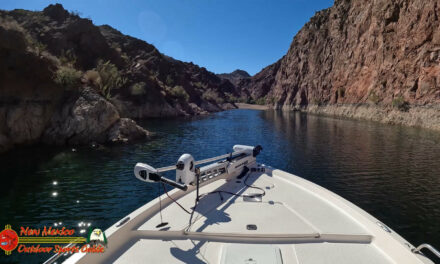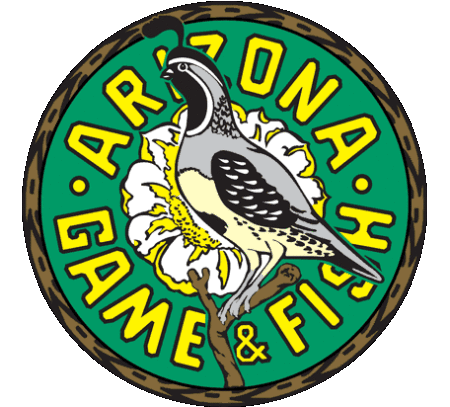Rig’N Up For The Big Ones – Lake Mohave
The tip of the fishing rod bounced twice, and then headed south. The hook was set, and Keith Kocurek of Pier 45 Marine in Houston let out a whoop. “Fish On!! Fish On”!!, he cried out to fellow fisherman Darren Landry. But Darren had problems of his own, since his fishing rod was also bent in a dangerous arc, as something on the other end of the line was heading for Cuba. This is rig fishing in the Gulf of Mexico … and the November action can be hot and heavy.
Whether you are free-lining a mullet or casting an artificial, when fishing around an oil rig the contest is not only between angler and fish, but also the fish and rig. The fisherman will usually have a limited amount of space to play the fish, and the fish will have ample opportunities for escape. Those ol’ barnacle-covered oil rig structures will test the strength and quality of your tackle, and also your patience.
If the resident fish are on the outside of the rig, sportsmen can usually employ lighter tackle such as 14- to 17-pound test line and conventional bass tackle to get them into the boat. If you are into bigger fish and they are making a home within the rig structure, it will take stout tackle and at least 25-plus pound test line to put up with the sharp teeth of the fish and the abrasion associated with contacting barnacles and rusty metal. A dipnet is essential to improve your fish landing odds, because rig-fish seem to have a tendency to do a bit of tail-walking when you get them close to the boat.
Most any variety of fish that pulls on the other end of your string can contribute to a good day of fishing, however, getting into a school of big snapper will create memories that will last a lifetime. These fish are usually pretty predictable and once hooked will fight tremendously hard. I prefer to use a rig with a sinker on one end, a couple of drops about 24-inches apart up the line tied to 4/0 Circle hooks, all coupled to a dark, barrel swivel between the leader and the main line. I believe that snapper become wary of the bright brass swivels, so that is the reason for the darker model. Put a couple of cigar minnows or icefish on as bait and you are likely to attract the attention of not only big snapper, but also species such as grouper, cobia, kings, shark, or perhaps a record size speckled trout. You never know what’s going to happen when you drop a bait around one of these oil rigs, but I guarantee that once you give it a try you will be hooked for life. JB.
**Here are a few tips from Capt. Stan J. Butaud — This winter the Gulf should produce excellent red snapper to 25 pounds and heavier. Be sure to take along your raingear and an extra set of clothes… just in case. Also double check the weather report and make sure that your VHF radio is working properly. You might consider wearing neoprene waders for extra warmth and protection from the wind and spray. Fishing has been great and we still have charters available during the next few months. Give me a call at …….
(713) 473-6363 for some great fishing action.
Swimming A Jig ‘N Pig With Pro Angler Tommy Biffle
By Jim Binns
November anglers who want to catch big bass will probably be flipping and pitching jigs. To increase productivity with the jig n’ pig, B.A.S..S. Mega Bucks champion and STREN Fishing Lines pro, Tommy Biffle, suggests changing jig and trailer colors and lure presentation.
“A jig n’ pig combo was designed to imitate a crawfish, an abundant springtime forage for bass,” Biffle explains. “However, during the Fall, largemouth key in on and actively feed on shad in preparation for the winter months ahead. Anglers should alter their jig and trailer colors and lure presentation to match the forage and entice more strikes. To make the jig n’ pig resemble a shad I switch from the standard dark colors to a white jig with a white or silver trailer. I also swim the jig through the cover rather than bumping it along the bottom. Frequent Fall cold fronts cause the bass to move tight to cover. By pitching and flipping, you can drop your lure into the cover and swim it right through the basses living room. And that’s what the bass are looking for … an easy prey.”
“Equipment plays a huge role in success when pitching or flipping,” states Biffle. “Plenty of anglers lose good fish because of their equipment. I use a 7 1/2-foot rod, 25-pound test Stren High Impact line and 1/4- to 3/8-ounce jigs with rattles embedded in them. The 7 1/2-foot rod provides the necessary backbone to pull a big fish from heavy cover. Stren’s High Impact line also provides tremendous strength and the abrasion resistance necessary when targeting heavy cover. Your fishing line is in constant contact with the cover, and as a result, damage to your line is commonplace. If you hook up with a big fish that you can’t immediately pull from the cover, the fish is going to wrap you up. Your only chance of landing the fish depends on the quality of your line.”
“Sharp hooks are also critical to hooking big bass. I suggest trimming the weedguard on the jig at the hook point to increase hook exposure. A weedguard that extends beyond the hook point may deflect the hook when making contact with the basses mouth. I also use jigs with rattles to create vibration in the water. Rising water and the rain that usually accompanies Fall cold fronts mean muddy water. Vibration is an added enticement that helps bass hone in on the lure. A quiet presentation of the lure also increases your ability to catch fish. As soon as the lure enters the water, swim it back through the cover. Swim the lure fast enough to keep it from sinking, and pump the rod every few seconds to create lure action. Eager bass holding in the cover will run right out of the bushes to chase the jig.”
“When you set the hook, don’t let your rod tip get in a high position. A high rod tip may cause the bass to jump, and if it gets airborne you’re sure to wind up with line tangled in the cover. If a bass does wrap you up, don’t pull the bass tight to the cover. The bass will use the coverage for leverage and dislodge the hook. Keep steady pressure on the fish, but let out two or three feet of line. Then move the boat to the bass, reach down and unwrap the line. Be prepared for missed fish. Have a couple of rigs with different color jigs and trailers. If you miss a fish, give the fish a quick look at a different color lure. You will be surprised how many fish you catch the second time around.”
Thanks to STREN and pro angler Tommy Biffle for the great Jig ‘N Pig fishing tips. – Lake Mohave








